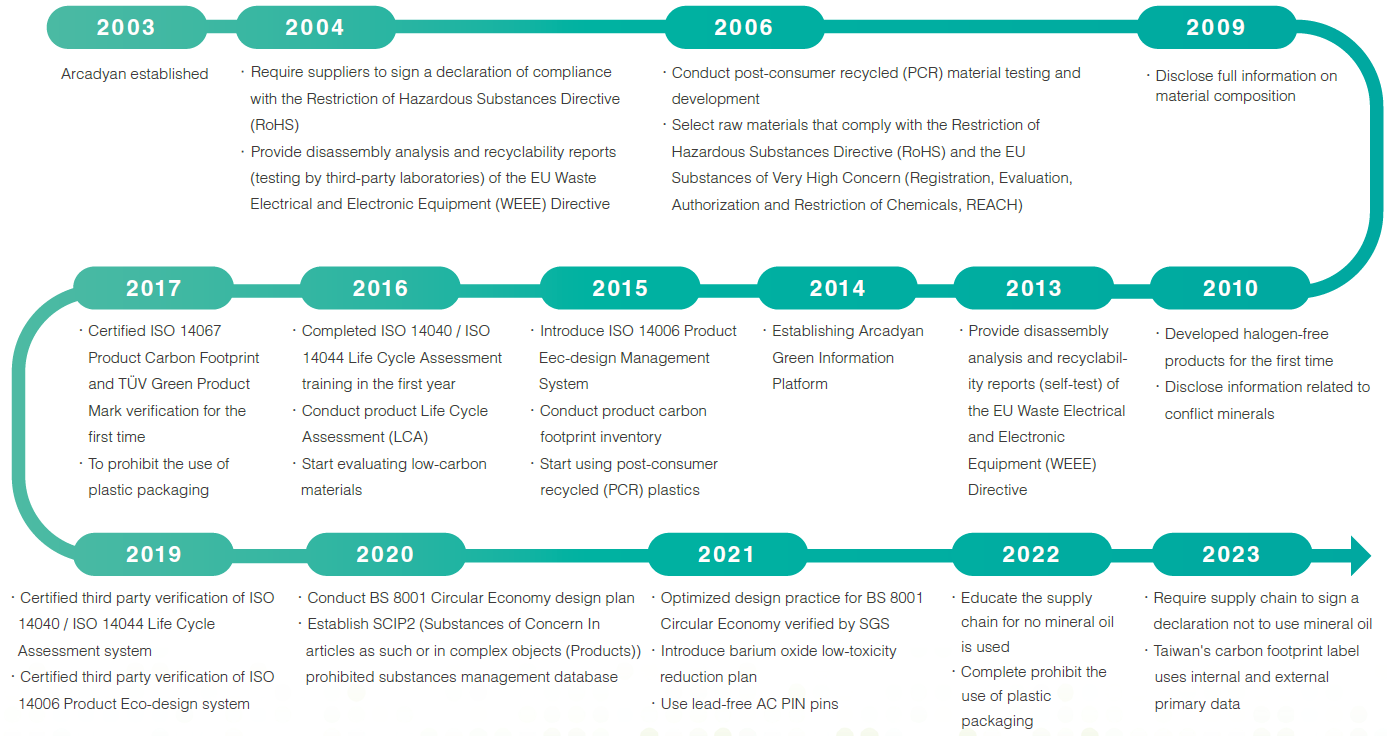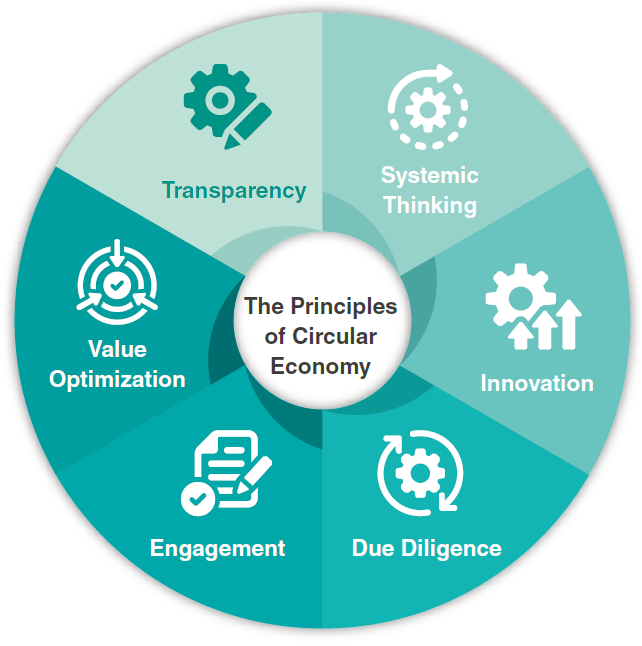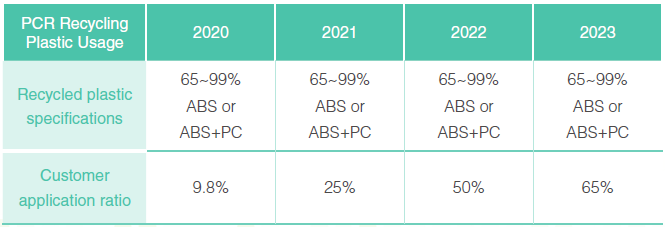Arcadyan involves all employees in green design, considering the environmental impact at every stage of the Product Life Cycle (PLC), from raw material procurement, production, packaging, and transportation, to consumer use and disposal. The company adopts the "Cradle to Cradle" approach, implementing a circular economy model of "Manufacture-Use-Recycle." This is achieved by redesigning products, changing business models, and enhancing resource and energy efficiency to prevent pollution and reduce waste at the source. The goal is to use fewer resources to create more value while reducing carbon emissions. Arcadyan implements ISO 14006 Eco-Design, leveraging innovative technology to mitigate the environmental impacts of climate change and enhance the sustainability value of its products. In 2023, 100% of Arcadyan's products complied with the European Union's Waste Electrical and Electronic Equipment (WEEE) Directive, meeting customer demands and legal requirements in all sales regions, with no incidents of non-compliance with product information labeling regulations or voluntary standards.

Arcadyan Sustainable Product Development Process
"Selection of low-toxic materials", "Saving electricity and low energy consumption", "Easy to disassemble and recycle", and "Extending product service life" are the core concepts of Arcadyan's sustainable product design. Since its establishment, Arcadyan continuously improved and enhanced its environmentally friendly design capabilities in response to international trends, stakeholder and customer needs every year to achieve the best eco-effectiveness.

BS 8001 Circular Economy Design Plan Introduction
Arcadyan implemented circular economy design plan in 2020, launching eight promotion stages based on six principles, and introducing design concepts based on the 10R strategy of the Dutch Environmental Assessment Agency (Planbureauvoor de Leefomgeving, PBL). In the material selection stage, priority to consider whether recycled plastics or metals can be applied to existing materials, or how to recycle the components into recycled materials through the recycling system when they cannot be used. In the product development process, consider maximizing the value of products and resources, and try to increase the proportion of postconsumer recycled (PCR) materials used in product casings and packaging. And to reduce the use of unnecessary parts and materials through design optimization and selection of high-quality parts. Discuss the operating model with customers, provide product repair and refurbishment services, to restore products to good condition through product repair and parts replacement to extend the life of the product; or, at the end of the product life cycle, product disassembly and classification can be performed on the client side, so that usable parts or materials can be recirculated into the manufacturing process, thereby practicing circular economy in the supply chain.

Arcadyan's excellent circular economy design capabilities are highly recognized. In 2023, from many participating manufacturers and Arcadyan won the Circular Economy Product Excellence Award from the China Economic Research Institute and the Green Economy Research Center, becoming a leader in green network equipment. This award commends Arcadyan for introducing circular economy thinking, reducing the impact of energy resources on the environment, trying to create more value with fewer resources, ensuring that the earth's limited resources can be used in a recycling and sustainable manner, reaching the goal of resource circular and zero waste.
Product Eco-design
Arcadyan certified ISO 14006 Product Eco-design System in 2018, and implemented product life cycle data collection and carbon inventory. The main assessment content includes four parts: purpose and scope definition, life cycle inventory analysis, life cycle impact assessment and life cycle interpretation. In addition to fully understanding the implementation practices of product environmental impact assessment, and using environmental information disclosure reports as necessary reference documents for external verification.Arcadyan ensures that the products and services provided comply with environmental and energy-related regulations, reduce the impact of the operation process on the environment, and achieve the Arcadyan's sustainable development goals. In 2023, Arcadyan assisted brand customers in inventorying product life cycles and product carbon footprints, accounting for 48.2% of the total annual product models.

-
Life CycleAssessment (LCA)
Arcadyan conducts life cycle assessment during the product development process, considering the actual and potential environmental impacts during the product life cycle from raw material acquisition, production, use, end-of-life processing, recycling and final disposal, including energy use, resources consumption, pollution emissions, etc. Also discuss and improve the assessment results with relevant departments, and continue to develop and produce environmentally friendly products.
In 2023, Arcadyan use LCA analysis software to assess environmental impact and product carbon footprint results in accordance with ISO 14040 and 14044 Life Cycle Assessment Standards. According to the IT Equipment Product Category Rules (PCR) of the EU Environmental Footprint Classification, the scope is defined from cradle to grave, which includes the raw material stage, manufacturing stage, distribution stage, use stage and waste treatment stage to measure the environmental impacts faced by operations, such as 28 ecological impacts such as climate change, human toxicity, freshwater toxicity and depletion of minerals, fossils and resources. In 2023, the number of products for which Arcadyan conducted life cycle analysis based on customer needs accounted for approximately 16% of the total shipments in 2023.
-
Energy-Related Products Directive (ErP)
Arcadyan selects high-efficiency power conversion devices, which can automatically enter pulse skip mode under light load conditions and reduce the switching frequency, and achieve the effect of improving conversion efficiency. Energy efficiency can be increased by 1~2% on average. Arcadyan products support or built-in Bluetooth functions. In the hardware design, WiFi and Bluetooth functions are used to replace physical connectors, with lower power consumption, higher transmission speed and longer transmission distance as the design goals, so that the product's short-range wireless transmission can be realized through WiFi and Bluetooth technology. Arcadyan also using smart microcontrollers (MCUs) to reduce product standby time and reduce product load to improve energy efficiency is expected to reduce product energy consumption by about 20~30%.
-
Easy to Disassemble /Recyclable Design
Arcadyan cooperates with customers' reuse / refurbish recycling policy and designs the product casing with one-hand opening to reduce the amount of engagement in the groove design. Easy-to-disassemble design and equipped with special fixtures, the product casing can be quickly and completely removed for repair or replacement of parts, improving the maintainability and repair-ability of the product. Through this design, each product can reduce carbon emissions by approximately 0.993 kgCO2e on average.
-
Renewable Material Design
Arcadyan uses plastics with high recycling potential to promote the recycling and use of waste plastics, effectively implements Post-Consumer Recycled (PCR) policies, and continues to increase the utilization rate of recycled materials. Arcadyan recycles the scrapped plastic casings and re-makes it into products again as new raw materials. Since 2015, 65% to 99% PCR recycled plastic has been introduced into plastic parts. In order to ensure that the recycled plastic made of ABS or ABS + PC does not affect the structural strength, a clip-on design is used to replace the general locking design, reducing the amount of screws and improving the convenience of final product and material recycling.

-
Environmentally Friendly Packaging Design
Arcadyan continues to aim at reducing the use of packaging materials, optimizing the
design of each product packaging during the research and development process, using stacking methods to increase the percentage of unit volume used, and improve the volumetric ratio of product transportation. Arcadyan uses recycled paper or Forest Stewardship Council (FSC) cardboard for product inner packaging, and prints it with plant-based inks to reduce the burden on the environment. In 2023, Arcadyan Vietnam Manufacturing Center obtained FSC (Forest Stewardship Council) certification, ensuring the traceability and quality of the forest-friendly packaging materials in the manufacturing center from raw materials to final products. FSC certified products accounted for 32.6% of total shipments in 2023.
Arcadyan uses biodegradable materials in the design of the packaging structure, and the ingredients come from industrial starch, plant fiber or paper foam. The production process of biodegradable materials is low-carbon and can be directly recycled or used as compost materials. They naturally degrade with low pollution and will not produce harmful residues. The proportion of recycled paper used in products shipped by Arcadyan in 2023 has reached more than 82%. Arcadyan will continue to develop and improve environmentally friendly packaging and make greater contributions to environmental protection.
